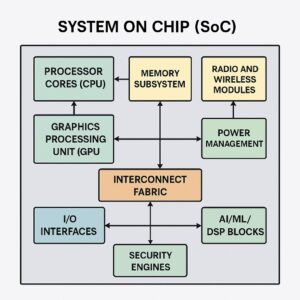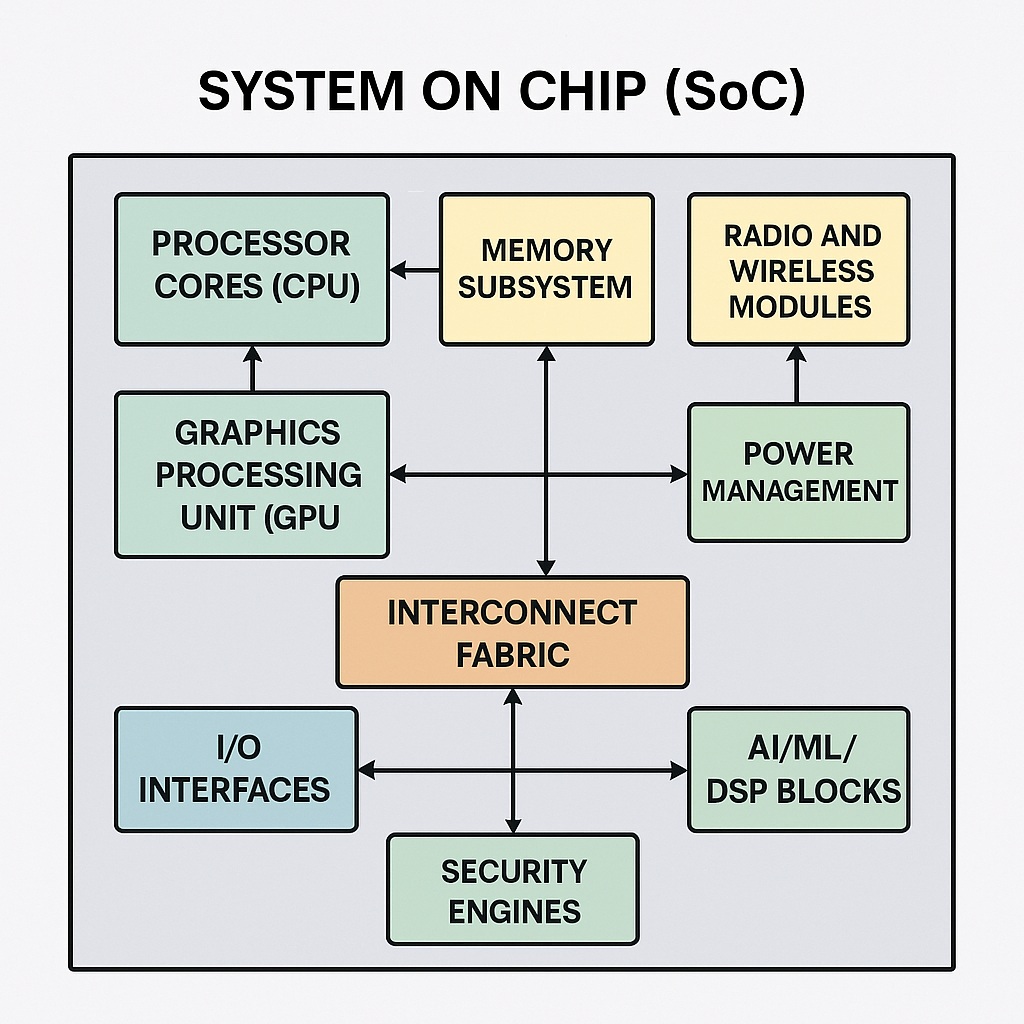
A System on Chip (SoC) is an integrated circuit (IC) that consolidates all—or most—components of a computer or electronic system onto a single chip. SoCs are foundational to modern electronics, powering everything from smartphones and tablets to automobiles, IoT devices, gaming consoles, and AI accelerators. They offer advantages in power efficiency, size, performance, and cost by integrating processing, memory, input/output (I/O), and specialized functionality into a single package.
Overview
Unlike traditional computer systems that separate CPU, GPU, memory, and peripherals into different components, an SoC integrates them into a compact, unified platform. This integration allows for:
-
Lower power consumption
-
Smaller physical footprint
-
Increased performance per watt
-
Reduced bill of materials (BoM)
-
Faster data communication among subsystems
Core Components
Most SoCs contain a combination of the following building blocks:
1. Processor Cores (CPU)
Typically ARM, RISC-V, or proprietary microarchitectures. May include:
-
Single-core or multi-core CPUs
-
32-bit or 64-bit architectures
-
Heterogeneous computing (big.LITTLE designs)
2. Graphics Processing Unit (GPU)
Integrated GPUs support 2D/3D rendering, video playback, and general-purpose GPU (GPGPU) workloads.
3. Memory Subsystem
-
SRAM and DRAM controllers
-
On-chip cache (L1, L2, L3)
-
eMMC, UFS, LPDDR, HBM, or DDR interfaces
4. Interconnect Fabric
A high-speed bus or Network-on-Chip (NoC) connects the subsystems (e.g., ARM AMBA, TileLink, AXI, CHI).
5. I/O Interfaces
-
USB, PCIe, HDMI, MIPI (CSI/DSI), GPIO
-
Ethernet, SATA, SDIO
6. Security Engines
-
Secure boot, encryption/decryption accelerators
-
TrustZone, TPM, secure enclaves
7. AI/ML/DSP Blocks
Many modern SoCs include neural processing units (NPUs), digital signal processors (DSPs), and vision processing units (VPUs) for edge AI and sensor processing.
8. Power Management
Integrated PMUs, dynamic voltage and frequency scaling (DVFS), power gating.
9. Radio and Wireless Modules (in mobile SoCs)
-
Wi-Fi, Bluetooth, LTE/5G, GNSS (GPS)
-
Often found in smartphone SoCs like Qualcomm Snapdragon or Apple’s A-series.
Types of SoCs
-
Application SoCs: Found in mobile phones, tablets, laptops (e.g., Apple M-series, Qualcomm Snapdragon).
-
Embedded SoCs: Used in industrial, medical, or automotive systems (e.g., NXP i.MX, Renesas R-Car).
-
IoT SoCs: Low-power SoCs for edge devices and wearables (e.g., Espressif ESP32, Nordic nRF52).
-
FPGA SoCs: Combine programmable logic with hard processor cores (e.g., Xilinx Zynq, Intel Stratix 10).
-
Automotive SoCs: Focus on functional safety, ADAS, and real-time processing (e.g., Nvidia DRIVE Orin, Tesla Dojo D1).
Design and Development
SoC design is complex and typically involves:
-
Hardware/Software co-design
-
Use of Hardware Description Languages (HDLs) like Verilog and VHDL
-
EDA tools from companies like Synopsys, Cadence, and Siemens EDA
-
IP integration: Licensing CPU cores (e.g., ARM Cortex), memory controllers, PHYs, etc.
-
SoC Verification: Using UVM, formal verification, emulation/prototyping platforms
-
Physical design and place-and-route: Follows logic synthesis
-
SoC tape-out and fabrication: At foundries like TSMC, Samsung, or Intel
Manufacturing Technologies
-
SoCs are built using CMOS process nodes ranging from legacy 130nm down to leading-edge 3nm and below.
-
Advanced nodes (e.g., TSMC N3, Intel 18A) enable higher performance and lower power.
-
3D packaging and chiplets (e.g., Intel Foveros, AMD Infinity Fabric) are extending SoC capabilities beyond monolithic designs.
SoC vs. Chiplet vs. CPU
| Feature | SoC | Chiplet | Traditional CPU |
|---|---|---|---|
| Integration Level | Very High (single die) | Modular (multi-die system) | CPU core(s) only |
| Target Use | Complete systems | High-performance systems | General-purpose compute |
| Flexibility | Limited post-fabrication | High (mix-and-match dies) | Moderate |
| Manufacturing Cost | Lower (at volume) | Higher (advanced packaging) | Moderate |
Examples of SoCs
-
Apple A17 Pro / M2 / M3 – Consumer mobile and PC-grade performance
-
Qualcomm Snapdragon 8 Gen 3 – High-end Android SoC
-
Nvidia Tegra Xavier / Orin – Automotive and robotics
-
Samsung Exynos – Mobile and mid-range
-
Intel Meteor Lake SoC – PC SoC with chiplet-based design
Future Trends
-
Chiplet-based SoCs: Hybrid designs using multiple dies for better yield and scalability.
-
Heterogeneous computing: Greater use of NPUs, GPUs, and custom accelerators.
-
AI at the Edge: SoCs increasingly optimized for on-device AI inference.
-
Secure SoCs: Hardware-level security features for trusted execution environments.
-
Design Automation and ML: Use of AI for EDA, design optimization, and verification.
Also Read:
Share this post via:















Quantum Advantage is About the Algorithm, not the Computer